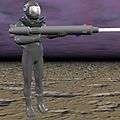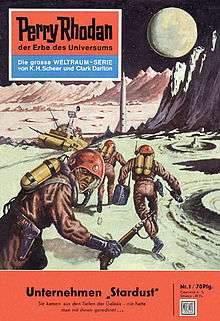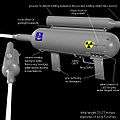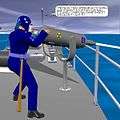Raygun

A raygun is a type of fictional device that fires a beam of (usually) destructive energy[1] used in science fiction; a form of directed-energy weapon. They have various alternate names: ray gun, death ray, beam gun, blaster, laser gun, phaser, zap gun etc. They are a well-known feature of science fiction; for such stories they typically have the general function of guns. In most stories, when activated, a raygun emits a ray, typically visible, usually lethal if it hits a human target, often destructive if it hits mechanical objects, with properties and other effects unspecified or varying.
Real-life analogues are particle-beam weapons or electrolasers, electroshock weapons which send current along an electrically conductive laser-induced plasma channel.
History
A very early example of a raygun is the Heat-Ray featured in H. G. Wells' novel The War of the Worlds (1898).[2] Science fiction during the 1920s described death rays. Early science fiction often described or depicted raygun beams making bright light and loud noise like lightning or large electric arcs.
According to The Encyclopedia of Science Fiction,[3] the word "ray gun" was first used by Victor Rousseau in 1917, in a passage from The Messiah of the Cylinder:[4]
All is not going well, Arnold: the ray-rods are emptying fast, and our attack upon the lower level of the wing has failed. Sanson has placed a ray-gun there. All depends on the air-scouts, and we must hold our positions until the battle-planes arrive.
The variant "ray projector" was used by John W. Campbell in The Black Star Passes in 1930.[1] Related terms "disintegrator ray" dates to 1898 in Garrett P. Serviss' Edison's Conquest of Mars; "blaster" dates to 1925 in Nictzin Dyalhis' story "When the Green Star Waned;" and "needle ray" and "needler" date to 1934 in E.E. Smith's The Skylark of Valeron.[5]
The term "ray gun" had already become cliché by the 1940s,[6] in part due to association with the comic strips (and later film serials) Buck Rogers and Flash Gordon. Soon after the invention of lasers during 1960, such devices became briefly fashionable as a directed-energy weapon for science fiction stories. For instance, characters of the Lost in Space TV series (1965–1968) and of the Star Trek pilot episode "The Cage" (1964) carried handheld laser weapons.[7]
By the late 1960s and 1970s, as the laser's limits as a weapon became evident, rayguns were dubbed "phasers" (for Star Trek), "blasters" (Star Wars), "pulse rifles", "plasma rifles" and so forth.
In his book Physics of the Impossible Michio Kaku used gamma ray bursts as an evidence to illustrate that extremely powerful rayguns like the one used to destroy a planet on Death Star in the Star Wars franchise do not violate known physical laws and theories. He further analyses the problem of rayguns' power sources.
Function
Ray guns as described by science fiction do not have the disadvantages that have, so far, made directed-energy weapons largely impractical as weapons in real life, needing a suspension of disbelief by a technologically educated audience:
- Ray guns draw seemingly limitless power from often unspecified sources. In contrast to their real-world counterparts, the batteries or power packs of even handheld weapons are minute, durable, and do not seem to need frequent recharging.
- Ray guns in movies are often shown as shooting discrete pulses of energy visible from off-axis, traveling slowly enough for people to see them emerge, or even for the target to evade them,[2] although real-life laser light is invisible from off-axis and travels at the speed of light. This effect could sometimes be attributed to the beam heating atmosphere that it was passing through. A possible evasion tactic is dodging the firing axis of the gun, theorized in the early story of Mobile Suit Gundam by the character Char Aznable when he first encountered the series protagonist's machine's beam rifle and seemingly dodging it without any difficulty.
Some of the effects are what would be expected from a powerful directed-energy beam, if it could be generated in reality:
- Ray guns are often shown as transmitting heat, as with Wells' heat rays.[2]
- Ray guns may be used to cut through hard materials like a blowtorch.[2]
But sometimes not:
- In movies, rays are often depicted as having effect instantaneously, with a touch of the beam sufficing for the intended purpose.[2] Raygun victims are generally killed instantaneously, often – as in the Star Wars films – without showing visible wounds or even holes in their clothing.[2]
- Some rayguns cause their targets to disappear ("de-materialize", disintegrate, vaporize or evaporate) entirely, personal equipment and all.
- Visible barrel recoil. This would only happen if the momentum of the beam were comparable to that of a bullet shot from a gun.
- A wide range of non-lethal functions as determined by the requirements of the story: for instance, they may stun, paralyze or knock down a target, much like modern electroshock weapons.[2] Occasionally the rays may have other effects, such as the "freeze rays" in the TV series Batman (1966–1968) and Underdog (1964–1970).[2] Many of the more implausible functions are almost farcical and include rayguns that age or de-age people (various cartoons); shrink rays (Fantastic Voyage, Honey, I Shrunk the Kids), and a "dehydration ray" (Megamind).
Ultimately, rayguns have whatever properties are required for their dramatic purpose. They bear little resemblance to real-world directed-energy weapons, even if they are given the names of existing technologies such as lasers, masers, or particle beams.[2] This can be compared with real-type firearms as commonly depicted by action movies, as tending infallibly to hit whatever they are aimed at (when wielded by the heroes) and seldom depleting their ammunition.[8]
Rayguns by their various names have various sizes and forms: pistol-like; two-handed (often called a rifle); mounted on a vehicle; artillery-sized mounted on a spaceship or space base or asteroid or planet.
Rayguns have a great variety of shapes and sizes, according to the imagination of the story writers or movie prop makers. Most pistol rayguns have a conventional grip and trigger, but some (e.g. Star Trek: The Next Generation phasers) do not. The shapes of some rayguns are influenced by an opinion that they look most effective and weapon-like if they look somewhat like real guns; others, such as this, are not:
 V-Gun from the Macross scenario: industrial look.
V-Gun from the Macross scenario: industrial look. "Plasma blaster": nuclear laboratory equipment look
"Plasma blaster": nuclear laboratory equipment look
(The V-Gun is treated as a Gatling gunpod in Macross, but as a laser when copied as Jetfire's gun in Transformers.)
Sometimes the end of the barrel expands into a shield, as if to protect the user from back-flash from the emitted beam.
Types
Types of Ray Guns
The ray is usually stated to be one of the following:
- Laser
- A real type of particle beam, e.g. protons and/or neutrons from the proton packs in Ghostbusters
- A fictional type of particle beam, such as:
- "Minovsky particles" in the Universal Century Gundam series scenario, where Minovsky Physics always operate; in the Mobile Suit Gundam 00 series, they use "GN particles" (a byproduct of a fictional topological defect baryon decay); and other timelines use other unknown particles.
- Nadions, in the well-known Star Trek phaser
- "Greek letter" rays other than the well known real-world alpha ray, beta ray, gamma ray. This includes delta rays and epsilon rays, which however have been given real-world meanings.
- Plasma; see also plasma rifle
- Defined by a word not known in real-world science, e.g. "disruptor".
- Stunner: non-lethal and only disable an opponent temporarily by knocking them out. They are often seen in television cartoons where realistic effects of real-world weapons would be disallowed due to restrictions of violence.[6]
- See Blaster (Star Wars)#Technology for an attempt (using unreal technology) at describing how a type of raygun works.
- Undefined
Rayguns are often one-handed, sometimes two-handed, and often artillery-sized fastened to a spaceship.
Rayguns powered by a backpack powerpack are described from time to time in science fiction.
Notable Ray Guns
The following is a partial list of types of rayguns mentioned in various science fiction scenarios:
- Blasters are the standard raygun of the Star Wars universe.
- Disruptors or disintegrator rays, weapons disruptive of the molecular structure of matter, are used in Star Trek and in Star Wars, among other works.
- Phasers are the standard raygun of the Star Trek universe; see also Weapons of Star Trek.
- Plasma rifles, shooting bolts of very hot ionized gas (plasma), are described by many works of fiction. One well-known example is the BFG 9000 in the Doom video games.
- Pulse rifle is the name for a wide range of fictional weapons in various works.
List of rayguns
Written Science Fiction

(*for series, year listed is the year of the first entry in the series.)
- War of the Worlds (1898): the Martians use a "Heat-Ray"
- The Messiah of the Cylinder (1917): first use of term "ray-gun"
- The Hyperboloid of Engineer Garin (1927): "hyperboloid", a highly concentrated collimated light beam weapon
- The Black Star Passes (1930) "Earth and Venus were each equipped with gigantic ray projectors, mighty ray guns that could destroy anything, even a body as large as the moon, at a distance of ten thousand miles."[1]
- The Skylark of Space series (1924): "needler"
- The Foundation Series (1942)
- Original trilogy: blaster: high-powered nuclear particles, shattering the target. Foundation models were seen to cause extensive damage to the surroundings, like shattering the wall behind the target.
- Prequels: blaster: weaker. Certain models have been known to kill without producing visible damage.
- Sequels: microwave gun
- First Contact (1945) by Murray Leinster: blasters are described as follows: "The blasters are those beams of ravening destruction which take care of meteorites in a spaceship's course when the deflectors cannot handle them. They are not designed as weapons, but they can serve as pretty good ones."
- Lucky Starr series (1952 on): blasters: small slugs which on impact turn a fraction of their mass into energy.

- Perry Rhodan (1961): the first installment shows a rifle-shaped raygun.
- Dune series (1963): Continuous-wave laser projectors called lasguns exist but are rendered obsolete by the use of personal Holtzman shields. The interaction of a lasgun blast and this force field results in a nuclear explosion which typically kills both the gunner and the target, to say nothing of collateral damage. Subsequently, lasguns are mostly mounted on aircraft.
- Hammer's Slammers (1979): "Powergun": a plasma pulse
- also by David Weber: **The Apocalypse Troll (1999): blaster: pulse of plasma
- The Hyperion Cantos (1989): "Death Wand": a laser-like beam weapon
Film and Television
- Alien film series: "PIG" plasma cannon: powered by a backpack powerpack. Uses an electrolaser to create a magnetic containment bottle.
- "Particle Beam Phalanx": cannon-sized.
- Babylon 5: "PPG" aka "Phased Plasma Gun"
- BattleTech: BattleMechs carry a wide variety of lasers, ether beamed or pulsed.
- Blake's 7: paragun: Federation standard issue. Image here. More Federation kit images here.
- a pistol: Federation issue, image here.
- The Day the Earth Stood Still: The alien visitor Klaatu's robotic bodyguard Gort had a disintegration beam which was shot from his 'eyes'. It could disintegrate weapons as large as a tank, or a rifle in a soldier's hands, without injuring the soldier.
- Despicable Me: Minion Mayhem: The Minionizer/Minion Ray Gun is used to turn humans into Minions.
- District 9: The film's protagonist Wikus uses an extremely powerful directed energy weapon (made by the film's resident aliens, pejoratively called prawns) that thoroughly destroys a human body on contact.
- Doctor Grordbort's Infallible Aether Oscillators: Rayguns utilizing "infra-wave undulation" and "phlogiston over-charging" amongst other pseudo-scientific concepts.
- Doctor Who: Daleks' guns: "ruby rays", Time Lord's "Stasers", Silurians "ray guns"
- Farscape: various weapons
- F.E.A.R.: "Armacham Type-7 Particle Weapon": plasma
- Forbidden Planet: hand blasters & larger blasters
- FreeSpace 2: photon beam cannons
- Ghostbusters: proton pack: particle beam
- Filmation's Ghostbusters: The Dematerializer: disintegrator beam (though it only works on ghosts)
- Gridlinked: pulse-gun: various types of fire mode
- Gundam
- Universal Century ("Gundam") series, mega beam cannons: "Minovsky particles" (and the degenerated Mega particles). (Minovsky Physics operate throughout series.)
- Independence Day: city-destroyer ray
- James Bond: Moonraker: "Moonraker laser": laser beam.
- Mars Attacks: Both the cards and movie feature alien weapons used by the Martians capable of disintegrating human/animal flesh, and on some occasions, terrestrial weapons and devices.
- Predator (franchise): Plasma caster, see Predator technology
- Sky Captain and the World of Tomorrow: An unnamed raygun firing glowing rings is used by Dex.
- Stargate: Staff Weapon: a yellow plasma-bolt
- intar: a red ball of energy
- Kull disruptor: a blue blast
- zat: a blue electrical discharge
- laser shotgun: a steady blue beam of energy
- laser RPG: a swirling mass of red and white energy
- Star Trek: See Weapons of Star Trek
- Star Wars: blaster: see blaster (Star Wars), which describes it in detail, but with unreal physics.
- various weapons: see List of Star Wars ranged weapons
- Teenage Mutant Ninja Turtles (1987 cartoon): traditional laser guns, carried by Bebop and Rocksteady[9]
- Terminator (franchise): Beam-weapons
- Transformers (film): Plasma cannon, Bumblebee's secondary weapon
- Ultraman franchise: In each successive series in the franchise, the series' Science Patrol carry a multitude of raygun and raygun-like weapons. Of particular note are the "Supergun", a folding weapon which shoots an electrical ray, and the "Mars 133", a more powerful variant capable of unleashing large explosions upon contact with the opponent.
- V: shock rifle and pistol: unknown
Games
- Blood and Blood II: Tesla Cannon: shoots electrical discharges
- Call of Duty: World at War and Call of Duty: Black Ops : have a Raygun in "Nazi Zombie mode" and can be obtained in the campaign mission 'Little Resistance' in World at War.
- Command & Conquer: Red Alert series - has a wide variety of weapons, as does Command & Conquer: Renegade
- Command & Conquer: Tiberium Wars (novel): T7: a Tiberium-fueled laser pulse
- EW1: a laser beam
- Scrin cannon: a beam of Tiberium particles
- Commander Keen: wielded a red raygun in the first game
- Crash Bandicoot: raygun: plasma of charged particles
- Darwin's World: role-playing game: laser rifle: Nd:YAG laser
- Descent series: laser pistols, fusion cannon, omega cannon
- Doom: Plasma rifle
- Fallout: "Solar Scorcher" (runs on solar power), "Alien Blaster", various laser, plasma and pulse weapons (rifles, handguns, Gatling guns, grenades)
- Half-Life: The Gluon gun (aka the Egon), a disintegration ray, and the Tau Cannon (aka the Gauss gun)
- Halo (series): various plasma weapons
- James Bond 007: Nightfire: Phoenix International Experimental Laser Rifle
- Kingdom Hearts II: Gun Arrow: bullet-like laser beams; freezes in midair before homing in on the target
- Kingdom of Loathing MMORPG: Toy Ray Gun: laser beam
- The Librarian: Quest for The Spear (2004): Tesla's "Legendary Death Ray"
- Metroid (video game series): various, see Items in the Metroid series
- Might and Magic VII: For Blood and Honor: typical blasters, similar to disintegrator guns, near the end of the game, created by the Ancients
- Phantom Crash (video game): scoobees or mechs carry ether shoulder or arm-mounted lasers
- Quake: BFG10K: plasma
- Resistance: Fall of Man: Auger: similar to Half-Life 2's "OSIPIR"
- Return to Castle Wolfenstein: "Tesla Gun": a multi-targeting electric shock gun
- Robotech: Reflex Cannon (artillery-sized)
- Stubbs the Zombie in Rebel Without a Pulse: raygun: a red/blue bullet of energy
- Super Smash Bros. series: "Ray Gun": plasma
- Total Annihilation: may be a traditional laser, or may use coherent meson or pseudo-boson beams instead
- Plasma Cannon: Bumble
- UFO: Enemy Unknown: laser pistols, laser rifles, heavy laser
- Unreal Tournament 2004: "Lightning Gun": an electrolaser
- Warhammer 40,000: numerous Imperial laser weapons (Lasgun, Laspistol, Lascannon, Volcano Cannon, Turbo-laser destructor, Ship-based Lances)
Gallery
 A typical imaginary raygun
A typical imaginary raygun Imaginary raygun, 2 views, with parts labelled
Imaginary raygun, 2 views, with parts labelled Small artillery sized version of same, being used.
Small artillery sized version of same, being used. Raygun with particle accelerator drum
Raygun with particle accelerator drum
Real-world development
- Radar is the result of attempts to develop rayguns before WWII
- CBS in their show 60 Minutes showed a real weapon described as a raygun. This video of it shows that it is most likely the Active Denial System.
- Recent real developments of laser guns have produced artillery-sized weapons which might be described as rayguns, but usually are not.
- See electrolaser for an electric current sent through a laser beam.
- See Directed-energy weapon for various real weapons which are more or less like rayguns.
- See Directed-energy weapon#Tesla for reports that Tesla made a real directed-energy weapon.
Distinguish from
- The "RayTek laser heat gun" (at search for heat gun) is a non-contact infrared thermometer, not a gun.
See also
References
- 1 2 3 Jeff Prucher, Brave New Words: The Oxford Dictionary of Science Fiction, Oxford University Press, 2007, page 162
- 1 2 3 4 5 6 7 8 9 Van Riper, op.cit., p. 46.
- ↑ Peter Nicholls, John Clute, and David Langford, "Ray Gun," The Encyclopedia of Science Fiction, 3rd edition, Jan 15, 2016
- ↑ Victor Rousseau , "The Messiah of the Cylinder", serialized in Everybody's Magazine, June–September 1917 ( ISFDB link).
- ↑ Winchell Chung, "Introduction to Sidearms", Project Rho: Atomic Rockets (accessed 3 March 2016)
- 1 2 "Ray Gun", TV Tropes (accessed 3 March 2016)
- ↑ Van Riper, A. Bowdoin (2002). Science in popular culture: a reference guide. Westport: Greenwood Press. p. 45. ISBN 0-313-31822-0.
- ↑ Van Riper, op.cit., p. 47.
- ↑ "Beneath These Streets". TV.com. 19 October 1989. Retrieved 1 October 2014.
External links
- Atomic Rocket: descriptions and technology and many images of handguns and rifle-sized guns used in space including rayguns.
- The Virtual Ray Gun Exhibition: Computer-generated ray gun art by various artists.